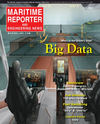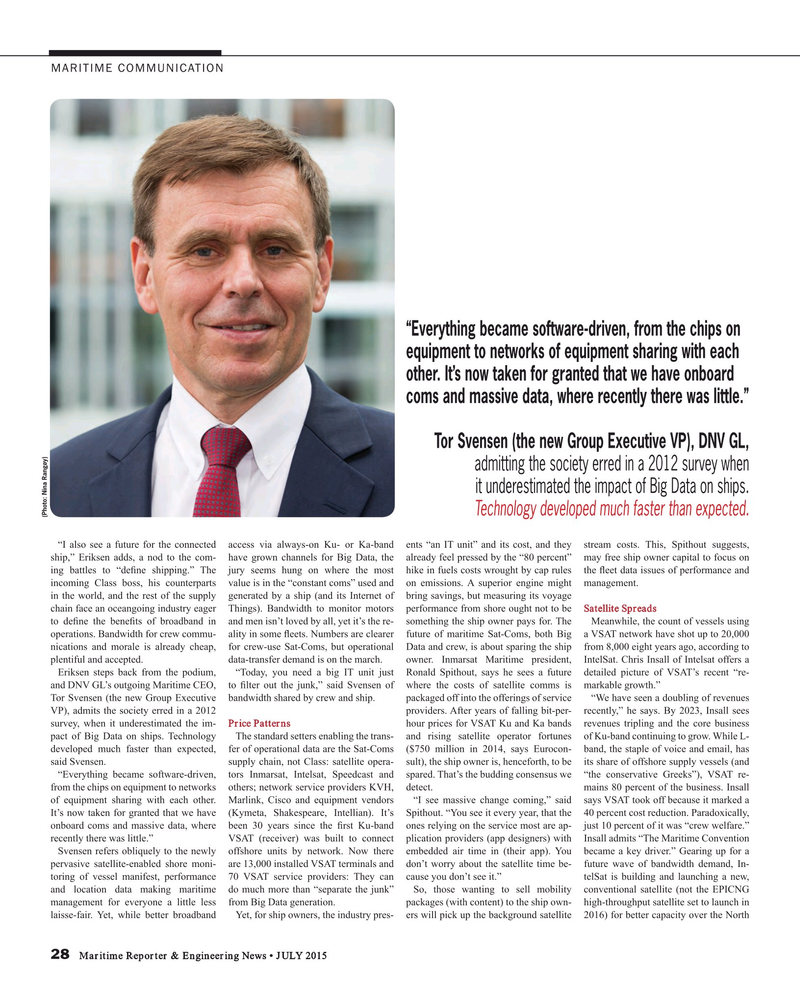
Page 28: of Maritime Reporter Magazine (July 2015)
Marine Communications Edition
Read this page in Pdf, Flash or Html5 edition of July 2015 Maritime Reporter Magazine
MARITIME COMMUNICATION “Everything became software-driven, from the chips on equipment to networks of equipment sharing with each other. It’s now taken for granted that we have onboard coms and massive data, where recently there was little.”
Tor Svensen (the new Group Executive VP), DNV GL, admitting the society erred in a 2012 survey when it underestimated the impact of Big Data on ships.
Technology developed much faster than expected.
(Photo: Nina Rangøy) “I also see a future for the connected access via always-on Ku- or Ka-band ents “an IT unit” and its cost, and they stream costs. This, Spithout suggests, ship,” Eriksen adds, a nod to the com- have grown channels for Big Data, the already feel pressed by the “80 percent” may free ship owner capital to focus on ing battles to “de? ne shipping.” The jury seems hung on where the most hike in fuels costs wrought by cap rules the ? eet data issues of performance and incoming Class boss, his counterparts value is in the “constant coms” used and on emissions. A superior engine might management.
in the world, and the rest of the supply generated by a ship (and its Internet of bring savings, but measuring its voyage chain face an oceangoing industry eager Things). Bandwidth to monitor motors performance from shore ought not to be Satellite Spreads to de? ne the bene? ts of broadband in and men isn’t loved by all, yet it’s the re- something the ship owner pays for. The Meanwhile, the count of vessels using operations. Bandwidth for crew commu- ality in some ? eets. Numbers are clearer future of maritime Sat-Coms, both Big a VSAT network have shot up to 20,000 nications and morale is already cheap, for crew-use Sat-Coms, but operational Data and crew, is about sparing the ship from 8,000 eight years ago, according to plentiful and accepted. data-transfer demand is on the march. owner. Inmarsat Maritime president, IntelSat. Chris Insall of Intelsat offers a
Eriksen steps back from the podium, “Today, you need a big IT unit just Ronald Spithout, says he sees a future detailed picture of VSAT’s recent “re- and DNV GL’s outgoing Maritime CEO, to ? lter out the junk,” said Svensen of where the costs of satellite comms is markable growth.”
Tor Svensen (the new Group Executive bandwidth shared by crew and ship. packaged off into the offerings of service “We have seen a doubling of revenues
VP), admits the society erred in a 2012 providers. After years of falling bit-per- recently,” he says. By 2023, Insall sees survey, when it underestimated the im- Price Patterns hour prices for VSAT Ku and Ka bands revenues tripling and the core business pact of Big Data on ships. Technology The standard setters enabling the trans- and rising satellite operator fortunes of Ku-band continuing to grow. While L- developed much faster than expected, fer of operational data are the Sat-Coms ($750 million in 2014, says Eurocon- band, the staple of voice and email, has said Svensen. supply chain, not Class: satellite opera- sult), the ship owner is, henceforth, to be its share of offshore supply vessels (and “Everything became software-driven, tors Inmarsat, Intelsat, Speedcast and spared. That’s the budding consensus we “the conservative Greeks”), VSAT re- from the chips on equipment to networks others; network service providers KVH, detect. mains 80 percent of the business. Insall of equipment sharing with each other. Marlink, Cisco and equipment vendors “I see massive change coming,” said says VSAT took off because it marked a
It’s now taken for granted that we have (Kymeta, Shakespeare, Intellian). It’s Spithout. “You see it every year, that the 40 percent cost reduction. Paradoxically, onboard coms and massive data, where been 30 years since the ? rst Ku-band ones relying on the service most are ap- just 10 percent of it was “crew welfare.” recently there was little.” VSAT (receiver) was built to connect plication providers (app designers) with Insall admits “The Maritime Convention
Svensen refers obliquely to the newly offshore units by network. Now there embedded air time in (their app). You became a key driver.” Gearing up for a pervasive satellite-enabled shore moni- are 13,000 installed VSAT terminals and don’t worry about the satellite time be- future wave of bandwidth demand, In- toring of vessel manifest, performance 70 VSAT service providers: They can cause you don’t see it.” telSat is building and launching a new, and location data making maritime do much more than “separate the junk” So, those wanting to sell mobility conventional satellite (not the EPICNG management for everyone a little less from Big Data generation. packages (with content) to the ship own- high-throughput satellite set to launch in laisse-fair. Yet, while better broadband Yet, for ship owners, the industry pres- ers will pick up the background satellite 2016) for better capacity over the North 28 Maritime Reporter & Engineering News • JULY 2015
MR #7 (26-33).indd 28 MR #7 (26-33).indd 28 7/6/2015 10:15:45 AM7/6/2015 10:15:45 AM

 27
27

 29
29
